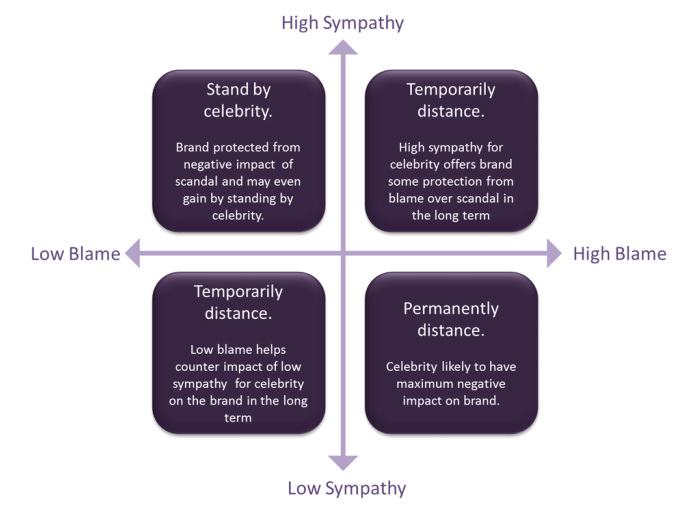 Who doesn’t love a celebrity sex scandal? In our celebrity obsessed culture, sex scandals don’t just make the news they are newsworthy in their own right. Images, interviews and social commentary about these events play out on all channels, including the most permanent one – the Internet. With easy access to volumes of information, people immerse themselves in playing both judge and jury. I’ll tell you who isn’t such a fan of the celebrity sex scandal. The Brand Manager whose celebrity just threw them under a bus by becoming front page tabloid news. Contrary to what you may have heard, not all sex sells. The psychology behind celebrity endorsements is simple. When consumers view a celebrity in a positive light and that celebrity also endorses a brand, then the brand benefits from also being seen in a positive light by association. It’s classic ‘Classical Conditioning’ and is an effective marketing strategy - until someone gets caught with their pants down. When celebrity endorsers misbehave and consumer opinion toward them sours, brands risk being tarnished by association. No doubt this was what AT&T, Accenture, Gatorade, Gillette and Tag Heuer were thinking when they severed their ties with Tiger Woods soon after news broke of his extra marital relationships. It was likely to be the reason why Ultimo Lingerie was quick to terminate its association with Peaches Geldolf after photos of her one night stand surfaced. Even if a brand doesn’t disconnect from their celebrity endorser permanently, it is still standard practice to pull all marketing communications and promotions until the scandal dies down. Which can prove costly, not only in lost revenue, but to the brand’s reputation. How academia has responded to the issue A recent article in the Psychology and Marketing Journal (cited in full at the end of article) gives us some idea about how to go about assessing the impact of celebrity endorser sex scandals on brands. Fong and Wyer Jr’s investigation into this topic was quite unique in that they have been one of the first in academia to research consumer attitudes toward celebrities and endorsed brands in the face of a real scandal. Previous research has been laboratory based, whereby scandals are fabricated to control for variables of interest. The scandal featured in Fong and Wyer Jr’s research related to the photos of Edison Chen, a Hong Kong actor, and various women from the Hong Kong entertainment industry, notably actress Gillian Chung. Over 400 sexually explicit photos were circulated in 2008 of which Chen admitted being the author and copyright owner. He denied being the publisher though, stating they had been stolen from his computer when sent for repair. The photos received widespread public attention with informal surveys suggesting up to 60% of Hong Kong residents had seen at least some of the photos. Some internet sites in Asia where photos were posted had recorded up to 20 million views per day. Eventually, the government declared the sharing of these photographs a criminal offense and arrested those responsible for publishing the images. A slew of brands distanced themselves from Chen to varying degrees in the wake of the scandal including Levis Jeans, Pepsi Cola, Samsung digital cameras, Hong Kong Metro, Standard Chartered Bank and Jacob & Co. Chung found herself facing similar treatment from Adidas Sportswear, French Bridal Salon, Disneyland, Perfect Shape, Epson printers and Metholatum Lip Balm. Fong and Wyer Jr used 147 university aged consumers to demonstrate the key steps in the decision making process that resulted in changes related to brand behaviours, echoing why some brands deem it necessary to sever their connection with their celebrity who behaved badly. This is what they found:
Figure 1. Consumer decision making process involving celebrity scandal and endorsed brands How a Brand Manager can make use of this knowledge How does knowing about this decision making process help a Brand Manager deal with their own scandal? The biggest issue in this situation is determining how much the brand is going to be negatively impacted by the scandal and whether the distance the brand puts between itself and the celebrity is going to be temporary or permanent. Talking to consumers will determine what direction the brand should move in. The first thing a brand manager needs to find out is the level of blame consumers hold toward the celebrity. Fong and Wyer Jr, for example, found that the females actresses involved in the Hong Kong sex scandal were perceived as less blameworthy than Chen. Even though Chen wasn’t responsible for publishing the photos, his computer was the source of the images thus making him appear more responsible for the events that unfolded. Basically, the more blameworthy the celebrity is perceived to be, the more of a negative impact they will have on the brand. The second thing a brand manager needs to figure out is what level of sympathy consumers hold toward the celebrity. The more sympathy consumers feel toward the celebrity the less likely consumer attitudes and behaviour toward the brand will be negatively affected. Based on the results obtained around blameworthiness and sympathy toward the celebrity in the scandal, we can populate a matrix outlining the four possible actions. Figure 2. Brand outcomes based on consumer reactions to celebrity scandal
When consumers have high levels of sympathy and low levels of blame for the celebrity, the brand is least likely to suffer negatively because consumer attitudes toward the celebrity are more likely to be positive. In this instance the brand may be wise to stand by the celebrity because consumers perceive the celebrity isn’t to blame in the situation and can sympathise with their plight. On the other hand, when consumers have low levels of sympathy and high levels of blame, they are more likely to be disappointed by the celebrity, leading them to have a similarly negative change of heart toward the brand. In this scenario, it may be safer for the brand to permanently distance itself from the celebrity. Scenarios of low blame and low sympathy or high blame and high sympathy both suggest the brand should temporarily distance themselves from the celebrity and wait and see if consumer sentiment shifts. How the celebrity handles themselves in the media or any additional events that unfold will have the potential to shift consumer opinion regarding consumer perceptions of blameworthiness and sympathy. Celebrity endorsement is a proven marketing strategy that gets brands noticed and drives purchase behaviour. Unfortunately, brand managers stand little chance of controlling the behaviours of their celebrity endorsers. With more and more celebrities behaving badly, being able to hone in on key factors in the consumer decision making process will help brand managers determine whether their celebrity investment is worth holding onto or should be dropped from their portfolio. Journal article details: Psychology & Marketing, November 2012, Vol 29(11), pp 807–917. Click here to obtain the article online.
0 Comments
Your comment will be posted after it is approved.
Leave a Reply. |
AuthorDonna Bonde is the Owner and Director of Rapture Consulting. She consults to agencies and brands who want to better understand the way consumers think and behave. She bases herself in Sydney, Australia. Archives
May 2024
Categories
All
|
Proudly powered by Weebly



